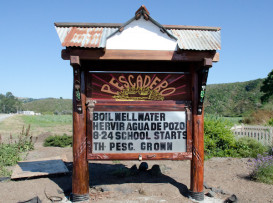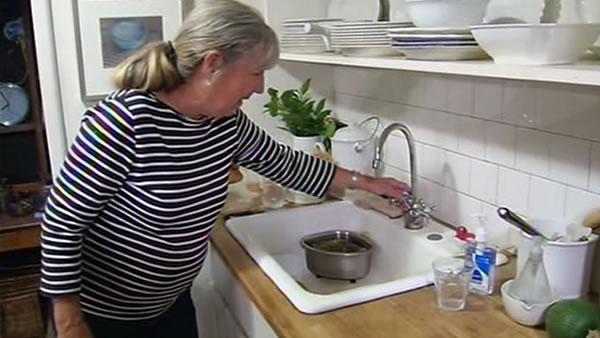Last month, Gov. Jerry Brown signed the Human Right to Water bill, which directs state agencies to make clean water a financing priority. The Bill declared that it is the established policy of the state that every human being has the right to safe, clean, affordable, and accessible water adequate for human consumption, cooking, and sanitary purposes. “Clean water ought to be a right,” said Bill Chiat, a program manager with the California State Association of Counties who educates government officials on water issues. “The question is, how are you going to pay for it?”
Access to clean, affordable, reliable water sources remains a key stumbling block for all South Coast residents –almost all have their own individual water and septic systems.
When you rely on groundwater, not city water the problems are complex – bacteria, barnyard run-off, pesticides and fertilizers, septic systems, excessive hardness (high dissolved magnesium and calcium content), a high concentration of salt or iron, or the presence of hydrogen sulfide (sulfur), methane gas, petroleum and organic compounds. Sometimes it’s supply, distribution and sustainability.
Two recent water episodes demonstrate the challenge of relying on wells in a rural town, and how vulnerable that water supply can be.

Chronic water problems plague Pescadero
Downtown Pescadero faces its share of serious water problems today. The well that supplies 100 water customers as well as every revenue generating business in Pescadero – the town’s only water infrastructure – broke down in August 2011 because over-pumping caused the water level to recede. A new pump, dropped lower in the aquifer, is a temporary fix. But Pescadero needs money for a new, deeper well – fast. A hydrological study determined that between 2010 and 2017, the well could fail for good.
Fortunately, the county is applying for a $700,000 state grant through Proposition 84, which has funds set aside for disadvantaged communities struggling with water problems. The money would pay for a new well, a new water tank, and a program to educate locals about water conservation.
“We are getting out ahead of this as much as possible, even though one could argue that it’s already happening,” says Nicholas Calderon, legislative aide to County Supervisor Don Horsley.
Horsley, who represents the South Coast, has already secured $150,000 to pay for a new hydrological report, and to design the new well if the grant comes in.
In the coming weeks, Puente will work with the County and the Rural Community Assistance Corporation to complete surveys to determine the region’s eligibility for state assistance.
Things are getting desperate everywhere, says Puente executive director, Kerry Lobel. La Honda has 67 water connections and a distribution system that is 100 years old.
“At the end of the day, something has to be done to finance water improvements in all our communities – in a way that doesn’t cost an arm and a leg,” she says.
But finances are the biggest stumbling block for communities like Pescadero and La Honda, where small groups of residents must bear the entire cost for maintaining and fixing these systems. Even after the state and county grants are factored in, Pescadero’s water “would still cost each ratepayer more than it would anywhere else,” says Calderon.
Solving the water quandary won’t be easy, but it will determine whether Pescadero can ever expand – and in turn, whether its schools and businesses can expand. Nothing else, except for jobs, is as important to the future of the community.

Individual Homeowners and Farmers Bear Brunt of Water Woes
More than 15 million households, or about 15 percent of all Americans, are served by a private well water system.
While the urbanized area of downtown Pescadero is served by the County-run public water system (CSA-11), homeowners and farms outside of downtown Pescadero are served by private wells or treated creek sources. This includes approximately 500 farm and nursery workers and their families who call the South Coast home.
Owners of permitted farm-labor housing are required by the state to provide potable water. Some of these farm-labor housing units are connected to community water systems regulated by the State or County, and must test their water on a regular basis depending on the number of people served by the water source. For a detailed graphic of the breakdown of California water systems, click here. Regardless of the level of regulation, the owners of these water systems themselves must bear the costs of installing, maintaining, and repairing their water systems.
After record-breaking rains in December, local water systems were particularly vulnerable to microbial contamination. This is precisely what happened at Bianchi Flowers, a nursery near Pescadero. Testing was done after the rains and a boil water notice was issued after E.coli contamination was discovered. The community water system there serves two shared barracks structures, multiple housing trailers as well as two additional houses on the property that landowner B.J. Burns and his family call home. Burns is one of the few landowners who actually lives on site.
He continues to chlorinate his and his tenants’ well water while he searches for a way to fix the problem – or drills another well, according to Leah Walker, chief of the California Department of Public Health’s Division of Drinking Water (CDPH) and Environmental Management. Burns is also in the midst of installing a water treatment system to address high levels of iron and manganese, naturally occurring minerals found in the aquifers throughout the area.
Kerry Lobel, executive director of Puente, says there is no evidence that the water sickened anyone, since most residents on the South Coast tend to drink bottled water. Still, Puente and Burns worked together to take action – Burns to find a long term solution to the issue and Puente to address the short term problem by talking with tenants make sure they understand the “boil water” notices taped to their doors.
CDPH has directed Bianchi Flowers to develop a new source of water that will comply with state drinking water standards.
“The only thing I’m concerned about is making sure that the water is clean and we prevent it from happening again,” says Lobel. That said, according to Lobel, the aging infrastructure on the South Coast makes it inevitable that more private well owners will face major equipment repairs and replacement in the years ahead. But small-town residents face an uphill fight for the healthy drinking water that most Californians take for granted.
By Julia Scott as part of the February Bridge newsletter.







